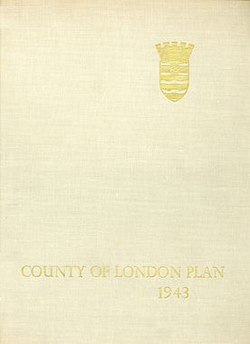County of London Plan
 |
|
| Author |
Patrick Abercrombie and J.H. Forshaw |
|---|---|
| Country | United Kingdom |
| Language | English |
| Subject | Urban planning |
| Publisher | Macmillan and Company Ltd |
|
Publication date
|
1943 |
| Media type | Print (Hardback) |
| Pages | 188 |
The County of London Plan was prepared for the London County Council in 1943 by Sir Leslie Patrick Abercrombie (1879–1957) and John Henry Forshaw (1895–1973).
Its main purpose was to point out the main directions of development and reconstruction of London, which in the past decades had faced big changes and irregular growth. It was prepared in anticipation of the end of World War II and the reconstruction after bomb damage and large movements of population.
It focused on five defects, for which it proposed remedies:
One of the solutions was ring roads around the capital. Construction would have involved considerable disruption, even through parts of the city damaged by bombs, and the roads were not built, but the "C Ring" (the third ring out from the city centre) was to include what is now the South Circular Road. The plan to build a high-quality road was not realised but the semi-circular route was assigned to existing roads through the southern suburbs. A similar plan was revisited in the 1960s under the name of the London Ringways.
In 1937, the Ministry of Transport published The Highway Development Survey by Sir Edwin Lutyens and Sir Charles Bressey, which reviewed London's road needs and recommended the construction of many miles of roads and the improvement of junctions at key congestion points. Among the proposals was a series of orbital roads around the city with the outer ones built as American-style parkways - wide, landscaped roads with limited access and grade-separated junctions.
The report recommended electrification of all rail routes and removal of viaducts, with the elimination of rail bridges over the Thames a key priority. It was hoped that the removal of the river bridges would enable the redevelopment of the South Bank.
The proposals included a highly ambitious system of two-track bored rail tunnels in loop-shaped routes beneath built-up areas, large enough to handle main-line trains. These tunnels would provide tube-like service but without the need to change from a main-line train to a tube train. As a result, some tube routes would be transformed into freight-only routes, with the northern portion of the Circle line specifically mentioned in this regard.
...
Wikipedia
